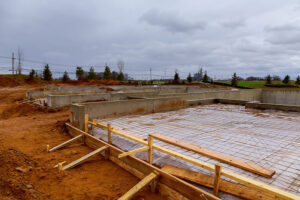Concrete Foundation Problems
Do You Have Concrete Foundation Problems?
Know what is causing your problems before it’s to advanced. A foundation problem may seem like a severe problem at first glance. However if you identify the damage and causes before it becomes to large, most foundation problems can be corrected and save you money if recognized in the early stages. Mares & Dow Construction & Skylights, is dedicated to providing you with the expertise information, correct foundation repair methods, systems and Grip -Tite Manufacturing products to solve your issues.
Concrete Foundation Problems & Failure Signs
 On your Home’s Interior you should look for the following:
On your Home’s Interior you should look for the following:
- Cracks in sheetrock/plaster walls or ceilings
- Cracks in walls and corners
- Cracks in walls above doors
- Trim or molding misaligned
- Torn or wrinkled wallpaper
- Doors and windows that stick or are to open/close
- Cracks in floor or tile
- Un-even floor surfaces or sloping of floor
- Cracks in concrete floors wider than 1/16th of inch
On your Home’s Exterior you should look for the following:
- Diagonal (stair-step) cracks in brick or stone walls
- Brick or mortar joints that vary in width
- Tilting or leaning chimney
- Separation of wood trim at joints and corners
- Fascia board pulling away
- Separation of concrete driveway, patio or sidewalk from the foundation
- Gaps around doors and windows
In your Home’s Basement you should look for the following:
- Bowed or leaning walls
- Cracks in foundation walls
- Cracks in block walls
- Foundations are sinking
- Water leakage through cracks in floors or walls
In your Home’s Garage you should look for the following:
- Bowed or leaning walls
- Cracks in foundation walls
- Cracks in block walls
- Foundations are sinking
- Water leakage through cracks in floors or walls
Concrete Foundation Problems & Failure Causes
Water And Soil
The ground your home is sitting on is so very important. Foundation settlement is the movement of your foundation when the soil around your foundation can no longer support the weight of the structure. In the San Francisco Bay Area we have several types and mixtures of soil.The three most common soils are sandy soils, loam soils and clay soils. Each one of these soils reacts different under wet or dry conditions. Sandy soils expand and contract very little with wet to dry water changes. Water passes through sandy soils. Loamy soils are also very stable and will change very little with water changes. Clay soil is the worst soil for damage to a foundation. Clay soil is the most porous of our soils in the Bay Area. Clay soil absorbs water at a high rate and can be the largest cause of foundation problems.
Drainage
Surface water around the house must not be allowed to stand or pond. If water is allowed to build up and soak into the soil around the foundation the soil will eventually weaken and become soft and the foundation will shift, sink and often times crack.
Evaporation-Drought
Long dry winters cause soil to dry out and shrink. When soil dries out for long periods of time the soil around the foundation often pulls away from the foundation and leaves gaps where the foundation can settle into and can cause sections of the foundation to crack.
Trees
Tree roots can dehydrate the soil around and under a foundation and leave gaps between the soil and the foundation. The foundation can settle in these gaps and can cause sections of the foundation to crack. Maturing trees can have root systems that have very large roots that press against the foundation and can cause foundation cracks. Arborist rule of thumb on tree roots is; if the branches of a tree extend over your home, most likely the roots will extend under the house also.
Plumbing Leaks & Broken Water Lines
Plumbing leaks in the house water lines can leak under a slab foundation or the perimeter foundation and cause the soil to become saturated and become a major cause of weakening the support and cause sinking. Or this may cause a pressure build up of the soil and cause lifting of the slab or foundation which is what we call heaving.
Poor Building Site Preparation or Compaction
Sometimes soil is removed from part of a building site or brought in from another location to fill hollow areas or is stacked on existing soil. This fill soil should be prepared or compacted properly before a foundation or slab is built on top of it. If the soil is not compacted correctly it may begin to settle underneath with the weight of the foundation, slab or home. This settlement will cause movement of the soil and result in settlement problems that can damage your foundation or slab.
Transform your home in San Francisco, CA, with our expert General Contracting Services. From simple updates to complete renovations, Mares & Dow Construction & Skylights has the expertise you need. Contact us for a free estimate and let us help you create the bathroom of your dreams.
